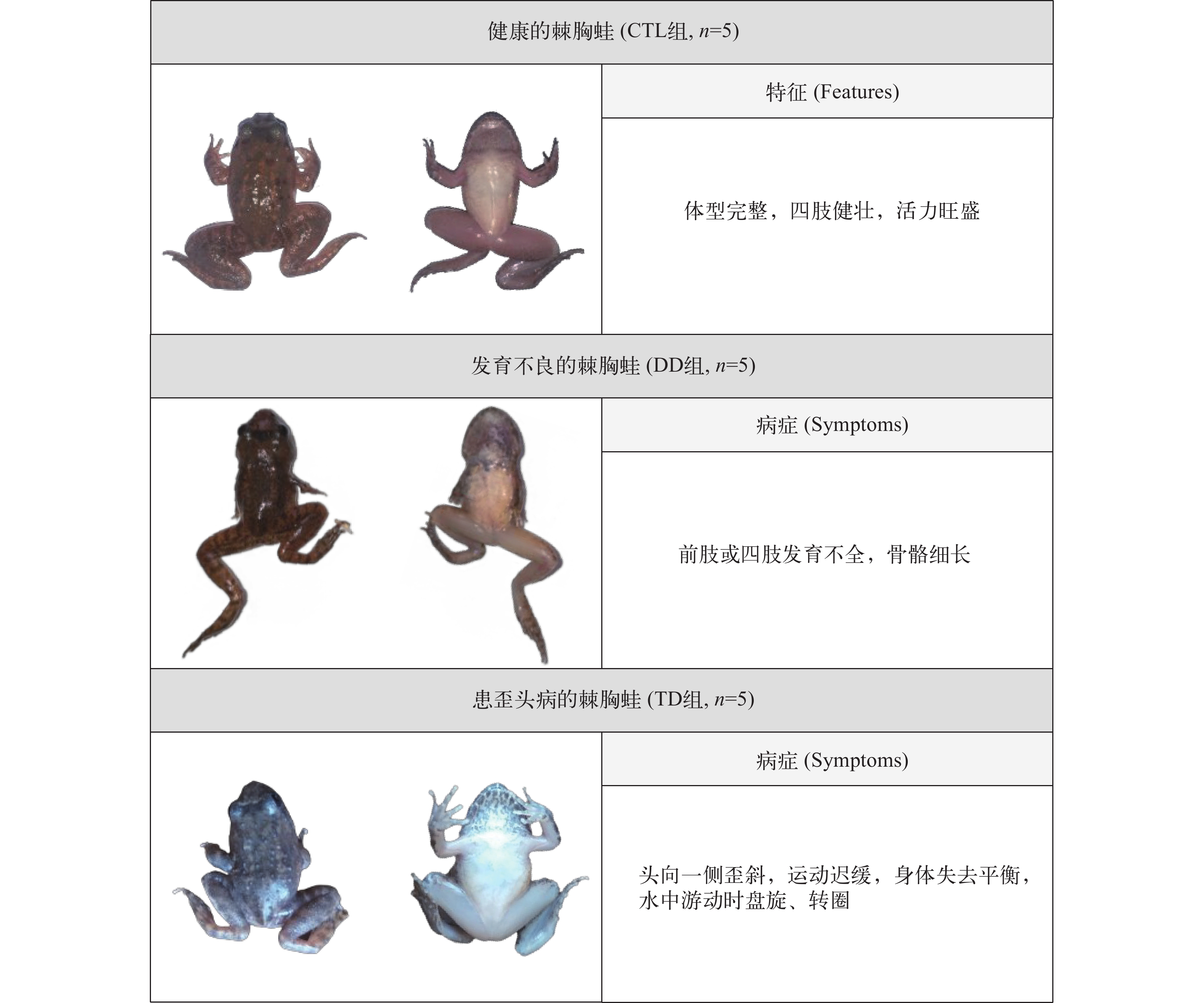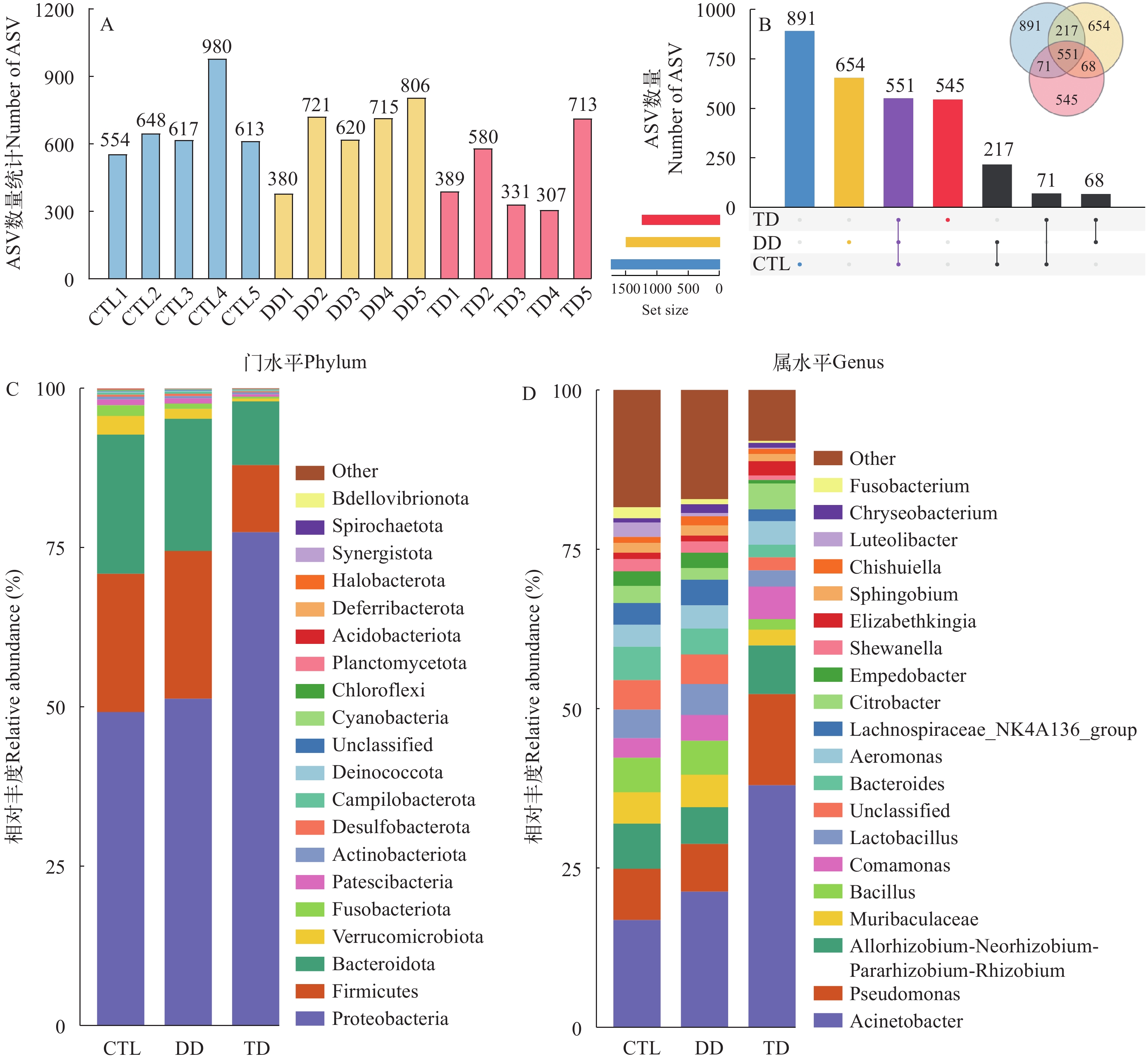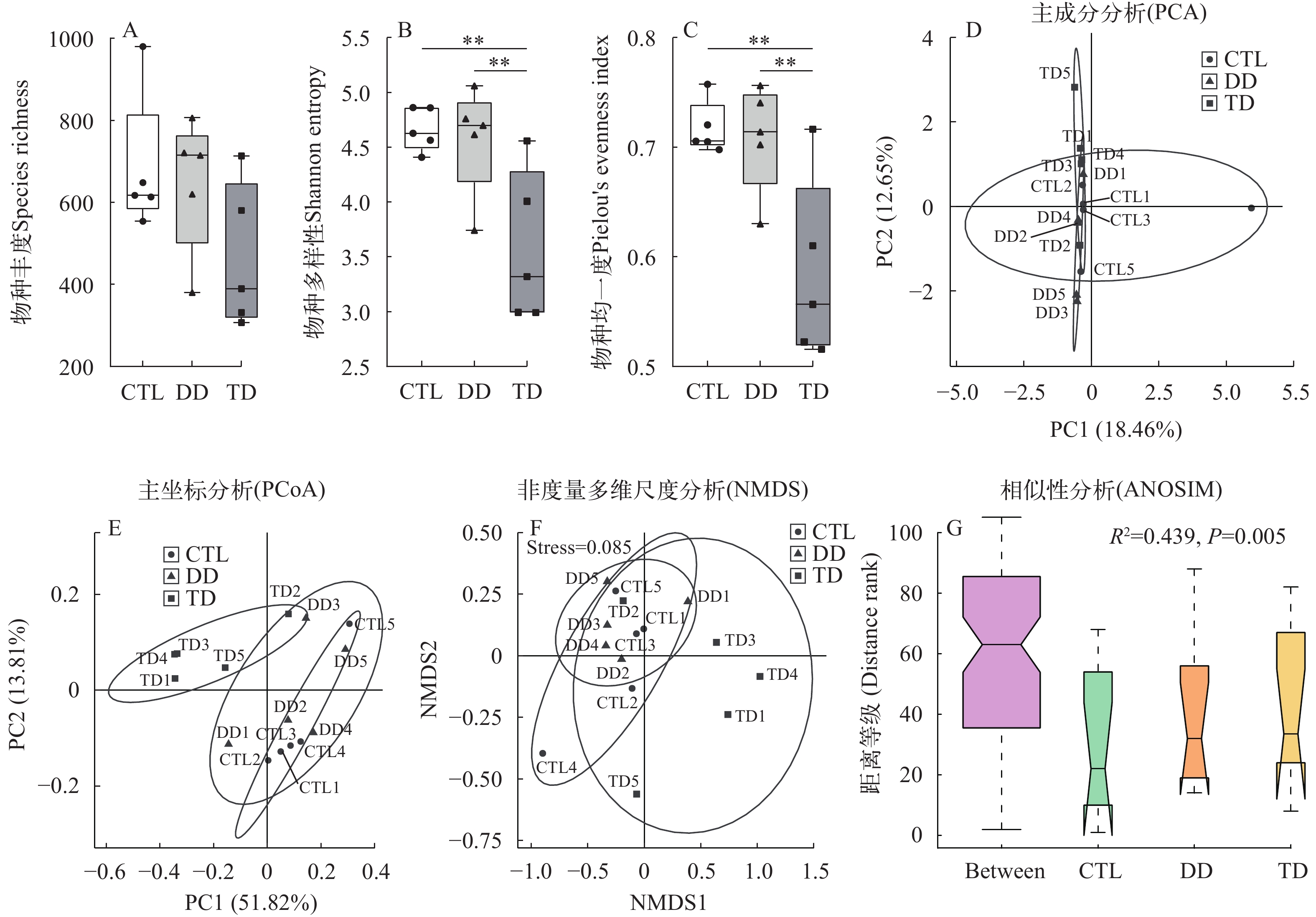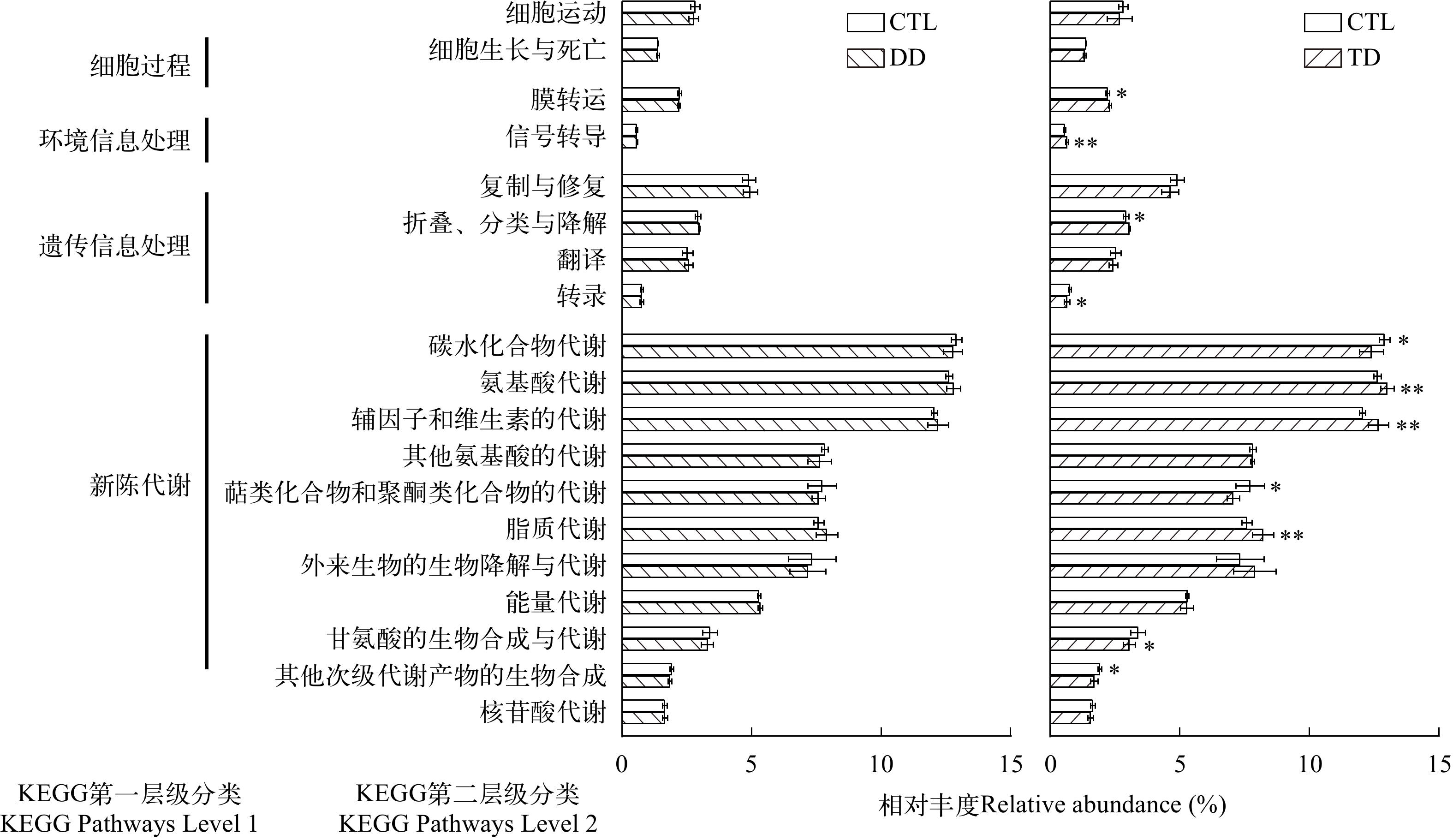DYSPLASIA AND TORTICOLLIS ON THE SKIN MICROBIOTA OF CHINESE SPINY FROG AT THE STAGE OF COMPLETE METAMORPHOSIS
-
摘要:
实验基于高通量测序技术, 以健康(CTL组)、发育不良(DD组)和患歪头病(TD组)的棘胸蛙(Quasipaa spinosa)为研究对象, 系统地探索宿主健康状态与皮肤微生物菌群组成、多样性及功能之间的潜在关系。所有样本经测序、质控及聚类获得2997条扩增子序列变体(ASVs), 注释32个门, 76个纲, 167个目, 259个科和402个属, 其中变形菌门(Proteobacteria)、厚壁菌门(Firmicutes)和拟杆菌门(Bacteroidota)为棘胸蛙皮肤主要优势菌门(>1%), 但丰度受宿主健康状态的影响。在属水平上筛选获得50个菌群标志物, 其中23个(如乳杆菌(Lactobacillus)、德沃斯氏(Devosia)、希瓦氏菌(Shewanella)和Luteolibacter)在CTL组中相对丰度较高, 提示棘胸蛙的健康状态; 19个(如短稳杆菌(Empedobacter)、芽孢杆菌(Bacillus)和短螺旋体(Brevinema))在DD组中相对丰度较高, 提示棘胸蛙发育不良的病症; 8个(如伊丽莎白菌(Elizabethkingia)、柠檬酸杆菌(Citrobacter)和不动杆菌(Acinetobacter))在TD组中相对丰度较高, 提示棘胸蛙歪头病的病症。多样性分析表明, TD组的多样性和均一度与CTL组和DD组相比显著降低, 微生物菌群组成也表现出明显分离。功能预测表明, CTL组和TD组皮肤微生物菌群之间功能差异主要富集在新陈代谢相关通路。总之, 该项研究揭示不同健康状态下棘胸蛙皮肤微生物菌群的组成和变化, 突出共生微生物菌群在两栖动物健康养殖和疾病预防中的潜在应用。
Abstract:The microbiota plays a critical role in amphibian health, however, the exact impact of disease on the host microbiota assembly remains unclear, and microbiota-based health assessment and disease prediction is a promising yet poorly established field. Chinese spiny frog (Quasipaa spinosa) is an important “famous, high-quality and new” cultured amphibian in China, but diseases have become a major bottleneck restricting the development of breeding industry, especially during the initial stages of complete metamorphosis. Disruption of homeostasis or failure to reconstruct the skin microbiota leads to a variety of diseases. In this study, Illumina high-throughput sequencing technology was utilized to systemically explore potential associations between host health status (healthy spiny frogs (CTL), dysplastic disease (DD), and torticollis disease (TD)) and the composition, diversity and function of the skin microbiota. A total of 2997 amplicon sequence variants (ASVs) were obtained by sequencing, quality control and clustering, annotating 32 phyla, 76 orders, 167 orders, 259 families and 402 genera. Proteobacteria, Firmicutes and Bacteroidota were the dominant phyla (>1%) shared by all groups, but their abundance was significantly modified by health status of the host. At the genus level, 50 sensitive taxa were screened with 23 (e.g., Lactobacillus, Devosia, Shewanella and Luteolibacter) exhibiting high relative abundance in the CTL group, indicating the health status of spiny frogs. 19 taxa (e.g., Empedobacter, Bacillus and Brevinema) showed high relative abundance in the DD group, indicating dysplasia in spiny frogs, and 8 taxa (e.g., Elizabethkingia, Citrobacter and Acinetobacter) had high relative abundance in the TD group, indicating torticollis. Alpha diversity analyses indicated that the TD group had significantly lower diversity and evenness compared to the CTL and DD groups, and the microbiota composition also exhibited distinct separation. Functional predictions indicated significant differences between the CTL and diseased groups, which were mainly enriched in metabolism-relevant pathways. In summary, this study depicts the composition and changes in the skin microbiota of spiny frogs under different health conditions, highlighting the potential application of symbiotic microbiota modification in healthy amphibian culture and disease prevention.
-
Keywords:
- Complete metamorphosis /
- Dysplasia /
- Torticollis /
- Skin microbiota /
- Quasipaa spinosa
-
两栖动物是水生向陆生演变的过渡群体, 在进化上占据重要地位, 同时在维持各种生态系统的平衡方面也发挥重要作用。但由于气候变化、生境破坏及过度捕捉等因素, 全球两栖动物种群受到严重威胁[1]。除了人为保护外, 人工繁育养殖通常也被认为是一种满足市场需求, 从而缓解野生两栖动物种群压力的有效措施[2]。然而在无尾类两栖动物的养殖过程中, 尤其是变态末期(Gosner stage 46, GS46), 宿主微生物菌群的稳态破坏及重建失败常常引发各类疾病, 造成巨大经济损失, 严重制约养殖产业的健康发展[3]。
变态末期(GS46)也称完全变态期, 是无尾类两栖动物生长发育阶段中从蝌蚪期过渡到幼蛙期的关键时期, 皮肤和肺取代鳃成为主要的呼吸器官, 栖息环境也由水生转变为水陆两栖, 此时皮肤微生物菌群组成结构重建并且受到水陆环境共同影响。此外, 两栖动物的皮肤作为直接与外界环境接触的黏膜表层, 既是重要的免疫器官, 也是抵御病原微生物的第一道防线[4]。目前, 病原体、微生物菌群及宿主健康状态之间的相互作用已成为研究热点, 定植于皮肤的共生微生物菌群在抵御病原体侵染及维持宿主健康状态方面的研究也得到广泛关注[5]。大量研究表明, 宿主皮肤微生物菌群稳态破坏及重建失败会引发机体生物学功能紊乱, 进而导致疾病的发生; 而感染反过来也会造成宿主皮肤微生物菌群的改变[6—8]。值得注意的是, 蝌蚪皮肤微生物菌群的早期破坏也会对成年蛙的抵抗力造成影响[9]。
棘胸蛙(Quasipaa spinosa)俗称石蛙、石鸡等, 是我国重要的“名特优新”养殖两栖类, 主要分布于我国南部地区及越南, 兼具食用和药用价值[10]。近年来, 野生棘胸蛙种群数量大幅缩减, 人工养殖产业快速发展, 养殖技术也日趋成熟。但是随着养殖规模不断扩大, 集约化程度不断加深, 病害防控已成为制约棘胸蛙养殖产业发展的主要技术瓶颈。棘胸蛙在养殖过程中容易受到病原侵染和环境胁迫而引发疾病, 尤其是变态末期棘胸蛙首次登陆, 栖息环境的改变导致其皮肤微生物菌群受水陆环境共同影响。此时, 皮肤微生物菌群的稳态破坏及重组失败导致疾病发生。因此, 本研究以变态末期健康、发育不良及患歪头病棘胸蛙为研究对象, 利用高通量测序技术系统地比较健康和患病棘胸蛙皮肤微生物菌群组成结构、多样性及生物学功能差异, 并筛选多个菌群标志物用于宿主健康评估与疾病预测, 以期从微生物角度为棘胸蛙健康养殖及病害防控提供参考依据。
1. 材料与方法
1.1 实验材料
实验用棘胸蛙(10.32±2.84) g均采自湖南省常德市石门县兴泉蛙业有限公司(111°02′40′′ E, 29°47′54′′ N)的同一养殖池, 包括健康个体(Health spiny frogs, CTL group, n=5)、发育不良个体(Dysplasia disease, DD group, n=5)及患歪头病个体(Torticollis disease, TD group, n=5; 图 1)。所采棘胸蛙均由同一批受精卵孵化发育而来, 遗传背景相同, 在整个养殖过程中定时定量投喂同种饲料, 并在采集时均处于变态末期(GS46)。
1.2 样本采集
样本采集前用无菌PBS (Phosphate buffered saline; cytiva, USA)冲洗个体, 确保采集微生物菌群来自蛙皮肤, 而非水体环境残留。参照Costa等[11]所述操作步骤, 使用无菌棉拭子擦拭蛙背部、腹部和四肢皮肤数次后立即将棉拭子置于无菌冻存管中, 液氮保存备用。
1.3 DNA提取
将棉拭子转移至含有1 mL无菌PBS的离心管中, 超声洗脱处理后保留液体用于DNA提取。根据说明书, 使用DNeasy® PowerSoil®试剂盒(QIAGEN, Germany)提取总微生物基因组DNA。琼脂糖凝胶电泳评估DNA质量, NanoDrop 2000光谱仪(Thermo Fisher Scientific, USA)测定DNA纯度和浓度。
1.4 DNA扩增及测序
使用带有特异性Barcode序列的通用引物338F (5′-AACTCCTACGGGAGGCAGCAG-3′)和806R (5′-GACTACHVGGGTWTCTAAT-3′)对16S rRNA的V3—V4高变区进行PCR扩增。根据说明书, 使用KAPA HiFi HotStart ReadyMix PCR试剂盒进行PCR扩增, 反应体系: 12.5 µL 2×KAPA HiFi HotStart ReadyMix、0.75 µL引物(10 mmol/L)和10 ng DNA模板, 用无菌水补齐至25 µL; 反应条件: 95℃预变性3min; 95℃变性30s, 55℃退火30s, 72℃延伸15s, 25个循环; 最后72℃延伸5min。琼脂糖凝胶电泳检测, 根据说明书, 使用SanPrep Column DNA Gel Extraction试剂盒(Sangon Biotech, China)对PCR扩增产物分离、纯化。使用Qubit荧光计(Thermo Fisher Scientific, USA)对各样本回收产物进行定量, 并按相应比例混匀。根据说明书, 使用TruSeq Nano DNA LT Library Prep试剂盒制备测序文库, 质检合格后交由武汉贝纳科技有限公司通过MiSeq平台(Illumina, USA)进行高通量测序。测序原始数据上传至NCBI的SRA (Sequence Read Archive)数据库(BioProject登录号: PRJNA964580)。
1.5 质量控制
使用FastQC软件[12]进行质量初筛后, 按照index和Barcode信息对序列进行划分, 使用Cutadapt软件[13]识别去除引物序列, 使用DADA2软件[14]进行过滤、去噪、拼接和去嵌合体等处理后得到有效序列。根据100%相似度进行序列聚类得到扩增子序列变体(Amplicon sequence variants, ASVs)。
1.6 数据处理及分析
使用R (R Core Team, New Zealand)的phyloseq包[15]将所有样本以丰度最小值抽平并过滤低丰度ASVs。使用R的VennDiagram包和UpSetR包绘制维恩图和UpSet图, 以展示不同组之间共有和特有的ASVs数目, 直观展示不同组ASVs的重合情况。基于Silva数据库(SSU138)[16], 使用QIIME2软件[17]对每个ASV进行物种注释。使用R的vegan包计算alpha多样性参数(Richness、Shannon和Pielou指数)并以箱线图直观展示组间微生物菌群丰度、多样性和均一度的差异。使用IBM SPSS® Statistics 19.0软件进行单因素方差分析, 以检验组间差异的显著性。使用R的microeco包, 基于Bray-Curtis相异度矩阵(加权)和Jaccard相似系数(非加权)进行beta多样性分析, 并以主成分分析(Principal component analysis, PCA)图、主坐标分析(Principal coordinates analysis, PCoA)图和非度量多维标度(Non-metricmulti-dimensional scaling, NMDS)图直观展示组间物种组成差异。使用R的vegan包进行相似性分析(Analysis of similarity, ANOSIM)以检验组间差异的显著性。通过LEfSe (Line discriminant analysis (LDA) effect size)分析[18]比较组间微生物菌群丰度差异, 筛选具有统计学差异的标记物种, 使用R的pheatmap包绘制热图以直观展示差异物种。使用PICRUSt2软件[19]进行微生物菌群功能预测, 使用STAMP软件[20]进行Welch’s t检验和多重检验校正(Benjamini-Hochberg FDR), 以检验组间差异的显著性。
2. 结果
2.1 微生物菌群物种组成分析
在本研究中, 15个棘胸蛙皮肤样本经高通量测序和质控筛选共计获得1854708条有效序列, 以100%相似度聚类后共计获得2997条ASVs。所有ASVs的样品覆盖率均高于99.4%, 表明测序和数据处理结果的可靠性。ASVs在各样本中的数量分布从307条(TD4)到980条(CTL4)不等, 平均值为598.27条(图 2A)。其中, 分别有891条、654条和545条是CTL组、DD组和TD组特有, 551条在3个组间共享(图 2B)。
![]() 图 2 健康和患病棘胸蛙皮肤微生物菌群组成分析A. 各样本ASVs数量统计; B. 组间共有和特有ASVs数量统计; C. 门水平组间皮肤微生物菌群组成及差异; D. 属水平组间皮肤微生物菌群组成及差异Figure 2. Composition of skin microbiota between healthy and diseased Chinese spiny frogsA. statistics on the number of ASVs; B. statistics on the number of shared and unique ASVs among groups; C. composition of skin microbiota at the phylum level; D. composition of skin microbiota at the genus level
图 2 健康和患病棘胸蛙皮肤微生物菌群组成分析A. 各样本ASVs数量统计; B. 组间共有和特有ASVs数量统计; C. 门水平组间皮肤微生物菌群组成及差异; D. 属水平组间皮肤微生物菌群组成及差异Figure 2. Composition of skin microbiota between healthy and diseased Chinese spiny frogsA. statistics on the number of ASVs; B. statistics on the number of shared and unique ASVs among groups; C. composition of skin microbiota at the phylum level; D. composition of skin microbiota at the genus level所有ASVs经物种注释分配至32个门, 76个纲, 167个目, 259个科和402个属。各组皮肤微生物菌群的共有优势菌门(>1%)主要由变形菌门(Proteobacteria; CTL: 49.20%, DD: 51.29%, TD: 77.41%)、厚壁菌门(Firmicutes; CTL: 21.70%, DD: 23.19%, TD: 10.52%)和拟杆菌门(Bacteroidota; CTL: 21.81%, DD: 20.73%, TD: 10.00%)组成, 疣微菌门(Verrucomicrobiota)是CTL组和DD组共有的优势菌门, 而梭杆菌门(Fusobacteriota)是CTL组特有的优势菌门(图 2C)。各组皮肤微生物菌群的共有优势菌属(>5%)主要由不动杆菌属(Acinetobacter; CTL: 16.62%, DD: 21.29%, TD: 38.58%)、假单胞菌属(Pseudomonas; CTL: 7.90%, DD: 7.47%, TD: 14.41%)和根瘤菌属 (Rhizobium; CTL: 6.95%, DD: 5.76%, TD: 7.71%)组成, 芽孢杆菌属(Bacillus)是CTL组和DD组共有的优势菌属, 而拟杆菌属(Bacteroides)、Muribaculum和丛毛单胞菌属(Comamonas)则分别是CTL组、DD组和TD组特有的优势菌属(图 2D)。
2.2 微生物菌群多样性分析
Alpha多样性研究表明, 健康和患病棘胸蛙皮肤微生物菌群的丰度没有显著差异(P>0.05; 图 3A), 但TD组的多样性和均一度相较于CTL组和DD组显著降低(P<0.01; 图 3B和3C)。基于Bray-Curtis相异度矩阵和Jaccard相似系数的beta多样性分析得到类似的结果, 因此本文只展示基于Bray-Curtis相异度矩阵的结果。类似于alpha多样性, CTL组和DD组的微生物菌群组成没有明显差异, 但与TD组相比展现出明显分离(图 3D—F)。相似性分析进一步证实, CTL组和DD组的beta多样性无显著差异(R2=0.072, P>0.05), 但与TD组(CTL: R2=0.620, P<0.01; DD: R2=0.632, P<0.01)相比具有显著差异(图 3G)。
![]() 图 3 健康和患病棘胸蛙皮肤微生物菌群多样性分析A—C. 健康和患病棘胸蛙皮肤微生物菌群alpha多样性参数(丰度、多样性和均一度)比较; D—F. 健康和患病棘胸蛙皮肤微生物菌群alpha多样性(PCA、PCoA和NMDS分析)比较; G. 相似性分析用以检验组间beta多样性差异的显著性Figure 3. Diversity of skin microbiota between healthy and diseased Chinese spiny frogsA—C. Comparison of alpha-diversity (Richness, Shannon, and Pielou indices) between healthy and diseased Chinese spiny frogs; D—F. Comparison of beta-diversity (PCA, PCoA, and NMDS analysis) between healthy and diseased Chinese spiny frogs; G. ANOSIM is conducted to evaluate the dissimilarity of beta-diversity analysis
图 3 健康和患病棘胸蛙皮肤微生物菌群多样性分析A—C. 健康和患病棘胸蛙皮肤微生物菌群alpha多样性参数(丰度、多样性和均一度)比较; D—F. 健康和患病棘胸蛙皮肤微生物菌群alpha多样性(PCA、PCoA和NMDS分析)比较; G. 相似性分析用以检验组间beta多样性差异的显著性Figure 3. Diversity of skin microbiota between healthy and diseased Chinese spiny frogsA—C. Comparison of alpha-diversity (Richness, Shannon, and Pielou indices) between healthy and diseased Chinese spiny frogs; D—F. Comparison of beta-diversity (PCA, PCoA, and NMDS analysis) between healthy and diseased Chinese spiny frogs; G. ANOSIM is conducted to evaluate the dissimilarity of beta-diversity analysis2.3 物种差异分析与菌群标志物筛选
LEfSe分析表明, 乳杆菌属(Lactobacillus)、德沃斯氏菌(Devosia)、希瓦氏菌属(Shewanella)和Luteolibacter在CTL组显著富集, 短稳杆菌属(Empedobacter)、芽孢杆菌属(Bacillus)和短螺旋体属(Brevinema)在DD组显著富集, 而伊丽莎白菌属(Elizabethkingia)、柠檬酸杆菌属(Citrobacter)和不动杆菌属(Acinetobacter)则在TD组显著富集(LDA>3.5; P<0.05; 图 4A)。此外, 在属水平上筛选获得50个菌群标志物, 其中23个在CTL组中相对丰度较高, 19个在DD组中相对丰度较高, 8个在TD组中相对丰度较高(图 4B)。
![]() 图 4 健康和患病棘胸蛙皮肤微生物菌群物种差异分析及菌群标志物筛选A. 健康和患病棘胸蛙皮肤微生物菌群物种差异分析; B. 指示棘胸蛙健康和患病状态的皮肤微生物菌群标志物及相对丰度Figure 4. Differential species analysis and indicator taxa screening between healthy and diseased Chinese spiny frogsA. LEfSe showing differences in the skin microbiota between healthy and diseased Chinese spiny frogs; B. Heatmap showing the relative abundances of the screened indicator taxa between healthy and diseased Chinese spiny frogs
图 4 健康和患病棘胸蛙皮肤微生物菌群物种差异分析及菌群标志物筛选A. 健康和患病棘胸蛙皮肤微生物菌群物种差异分析; B. 指示棘胸蛙健康和患病状态的皮肤微生物菌群标志物及相对丰度Figure 4. Differential species analysis and indicator taxa screening between healthy and diseased Chinese spiny frogsA. LEfSe showing differences in the skin microbiota between healthy and diseased Chinese spiny frogs; B. Heatmap showing the relative abundances of the screened indicator taxa between healthy and diseased Chinese spiny frogs2.4 KEGG功能预测
通过PICRUSt2对健康和患病棘胸蛙皮肤微生物菌群进行功能预测, 共计鉴定发现19条主要的第二层级KEGG通路(>1%; 图 5)。其中, CTL组和DD组皮肤微生物菌群在功能上无显著差异, 而CTL组和TD组之间功能的显著差异主要富集在新陈代谢相关通路, 如碳水化合物代谢、氨基酸代谢、辅因子和维生素的代谢、萜类化合物和聚酮类化合物的代谢、脂质代谢、甘氨酸的生物合成与代谢及其他次级代谢产物的生物合成(图 5)。
3. 讨论
棘胸蛙是我国重要的“名特优新”养殖两栖类, 然而在养殖过程中, 尤其是变态末期首次登陆, 随着栖息环境的改变, 皮肤微生物菌群稳态破坏和重建失败会引发疾病, 严重制约养殖产业发展。因此, 本文以变态末期健康、发育不良和患歪头棘胸蛙为研究对象, 利用高通量测序技术系统分析健康和患病蛙之间皮肤微生物菌群的组成、多样性及功能差异, 并筛选多个菌群标志物用于宿主健康评估与疾病预测, 系统地探索宿主健康状态与皮肤微生物菌群之间的潜在关系。
3.1 健康状态对皮肤微生物菌群组成及丰度的影响
研究表明, 放线菌门(Actinobacteriota)、厚壁菌门(Firmicutes)、变形菌门(Proteobacteria)和拟杆菌门(Bacteroidota)是构成脊椎动物皮肤微生物菌群的主要优势菌门[21]。本研究发现, 健康、发育不良和患歪头病棘胸蛙皮肤微生物菌群的共有优势菌门主要由变形菌门、厚壁菌门和拟杆菌门组成, 与中国大鲵(Andrias davidianus)[22]、中国林蛙(Rana chensinensis)[23]、虎纹蛙 (Hoplobatrachus rugulosus)[2]和意大利林蛙(R. italica)[24]等两栖动物的皮肤微生物菌群结构高度相似。因此, 我们推测变形菌门、厚壁菌门和拟杆菌门是定植于两栖动物皮肤的主要固有微生物菌群。然而, 这些菌门的丰度在组间存在显著差异, 如TD组中拟杆菌门和厚壁菌门的丰度显著降低, 而变形菌门显著升高。值得注意的是, 厚壁菌门下的多数菌属被认为是有益菌, 能够维持宿主皮肤酸性环境并发酵产生活性物质, 帮助宿主抵御病原微生物入侵[22]。拟杆菌门的成员也与宿主的免疫及代谢过程密切相关[25]。而变形菌门则是革兰氏阴性菌的主要门, 包括多种病原体和条件致病菌, 变形菌门丰度增加可能是疾病的微生物特征[26]。因此, 我们推测患歪头病棘胸蛙皮肤厚壁菌门和拟杆菌门丰度的显著降低及变形菌门显著升高提示外界病原微生物侵染与定植以及宿主抗病能力衰退和免疫功能障碍。
3.2 健康状态对皮肤微生物菌群多样性的影响
一般而言, 微生物菌群多样性高意味着对环境压力具有更高的抗性和恢复能力, 因此在维持宿主健康状态中也发挥关键作用[21]。在本研究中, TD组的皮肤微生物菌群多样性和均一度显著降低, 提示棘胸蛙对环境病原体的抵抗力下降可能是导致其患歪头病的重要因素之一。此外, TD组的菌群组成结构与其他组相比也表现出明显分类聚集, 表明棘胸蛙皮肤微生物菌群多样性和菌群组成与歪头病密切相关。然而, CTL组和DD组的皮肤微生物菌群多样性无显著差异, 菌群组成结构与其他组相比也无明显分离。鉴于肠道微生物菌群在介导消化、吸收及机体生长发育中的关键作用, 我们推测棘胸蛙发育不良的病症可能在很大程度上归因于变态末期肠道菌群稳态破坏及重构失败, 而非皮肤微生物菌群[27]。
3.3 皮肤微生物菌群差异分析及菌群标志物筛选
通过比较健康和患病棘胸蛙皮肤微生物菌群的丰度差异筛选获得多个敏感菌属, 如乳杆菌属(Lactobacillus)、希瓦氏菌属(Shewanella)、伊丽莎白菌属(Elizabethkingia)、柠檬酸杆菌属(Citrobacter)及不动杆菌属(Acinetobacter)等。乳杆菌属和希瓦氏菌属中的绝大多数成员为益生菌, 已有研究证实其与两栖类健康状态之间的潜在关系。如定植于牛蛙(Lithobates catesbeianus)皮肤和肠道的乳杆菌对蛙壶菌(Batrachochytrium dendrobatidis)及嗜水气单胞菌(Aeromonas hydrophila)等病原具有拮抗作用, 并可调节宿主免疫功能[28, 29]。摄食添加希瓦氏菌可显著提高皱纹盘鲍(Haliotis discus hannai Ino)和南美白对虾(Litopenaeus vannamei)等的生长性能、免疫反应及抗病能力[30, 31], 也可缓解体表受损大西洋鲷(Sparus aurata L.)伤口区域的炎症反应, 促进伤口愈合和受损皮肤再生[32]。而伊丽莎白菌属、柠檬酸杆菌属和不动杆菌属中的绝大多数成员则为自然界中广泛存在的条件致病菌。其中伊丽莎白菌已被证实是引起蛙类歪头病以及白内障的主要致病菌[33, 34], 柠檬酸杆菌是导致蛙类红腿综合征、溃烂病、歪头病及白内障的主要致病菌[35], 而不动杆菌则与蛙类出血病和腐皮病密切相关[36—38]。因此, 我们推测乳杆菌和希瓦氏菌是定植于棘胸蛙皮肤的有益菌, 而伊丽莎白菌、柠檬酸杆菌及不动杆菌则是潜在致病菌, 其丰度的动态变化可能在很大程度上与宿主的健康状态密切相关。
在属水平上筛选获得50个菌群标志物, 分别有23个、19个和8个在CTL组、DD组和TD组中具有高相对丰度。与微生物菌群差异分析相符, 健康蛙的菌群标志物多为有益菌属, 其相对丰度高提示宿主的健康状态, 而患病组的菌群标志物多为潜在的致病菌属, 其相对丰度升高提示宿主的病理状态。在生产实践中, 通过检测这些菌群标志物的相对丰度及动态变化预测和评估宿主健康状态或发病趋势, 为棘胸蛙健康养殖与疾病防控提供参考[39—41]。
3.4 健康状态对皮肤微生物菌群功能的影响
在正常情况下, 微生物菌群定植于宿主皮肤、肠道等部位, 以特定方式与宿主共生, 介导消化吸收、代谢、抗病、免疫调节及生长发育等多种生物学功能[42]。而疾病状态导致宿主微生物群动态平衡破坏, 引起微生物群生物学功能紊乱; 另一方面, 微生物菌群失调又会引起生物学功能障碍, 导致宿主对病原体的易感性增加[43]。研究表明, 拟杆菌门和厚壁菌门在代谢中起关键作用, 而厚壁菌门/拟杆菌门比例增加会导致宿主代谢失调[44]。在本研究中, 患病棘胸蛙皮肤厚壁菌门/拟杆菌门比例均高于健康蛙, 并且健康和患歪头病蛙的皮肤微生物菌群功能差异主要集中于新陈代谢相关通路, 如碳水化合物代谢、氨基酸代谢以及脂质代谢等, 提示棘胸蛙的健康状态可能与皮肤微生物菌群的代谢功能相关。
4. 结论
本文基于高通量测序对变态末期健康、发育不良及患歪头病的棘胸蛙皮肤微生物菌群进行系统的比较研究。结果表明, 变形菌门、厚壁菌门和拟杆菌门是定植于棘胸蛙皮肤的优势菌门, 其丰度受宿主健康状态影响。基于相对丰度在属水平上筛选获得乳杆菌、希瓦氏菌、伊丽莎白菌、柠檬酸杆菌以及不动杆菌等多个菌群标志物。此外, 疾病显著破坏棘胸蛙皮肤微生物菌群多样性, 还会导致皮肤菌群介导的代谢功能紊乱。综上所述, 我们的研究结果阐明了不同健康状态下棘胸蛙皮肤微生物菌群的组成和变化, 为后续研究微生物菌群扰动的致病机制提供参考, 突出皮肤微生物菌群在两栖动物的健康养殖和疾病防控中的潜在应用。
-
图 2 健康和患病棘胸蛙皮肤微生物菌群组成分析
A. 各样本ASVs数量统计; B. 组间共有和特有ASVs数量统计; C. 门水平组间皮肤微生物菌群组成及差异; D. 属水平组间皮肤微生物菌群组成及差异
Figure 2. Composition of skin microbiota between healthy and diseased Chinese spiny frogs
A. statistics on the number of ASVs; B. statistics on the number of shared and unique ASVs among groups; C. composition of skin microbiota at the phylum level; D. composition of skin microbiota at the genus level
图 3 健康和患病棘胸蛙皮肤微生物菌群多样性分析
A—C. 健康和患病棘胸蛙皮肤微生物菌群alpha多样性参数(丰度、多样性和均一度)比较; D—F. 健康和患病棘胸蛙皮肤微生物菌群alpha多样性(PCA、PCoA和NMDS分析)比较; G. 相似性分析用以检验组间beta多样性差异的显著性
Figure 3. Diversity of skin microbiota between healthy and diseased Chinese spiny frogs
A—C. Comparison of alpha-diversity (Richness, Shannon, and Pielou indices) between healthy and diseased Chinese spiny frogs; D—F. Comparison of beta-diversity (PCA, PCoA, and NMDS analysis) between healthy and diseased Chinese spiny frogs; G. ANOSIM is conducted to evaluate the dissimilarity of beta-diversity analysis
图 4 健康和患病棘胸蛙皮肤微生物菌群物种差异分析及菌群标志物筛选
A. 健康和患病棘胸蛙皮肤微生物菌群物种差异分析; B. 指示棘胸蛙健康和患病状态的皮肤微生物菌群标志物及相对丰度
Figure 4. Differential species analysis and indicator taxa screening between healthy and diseased Chinese spiny frogs
A. LEfSe showing differences in the skin microbiota between healthy and diseased Chinese spiny frogs; B. Heatmap showing the relative abundances of the screened indicator taxa between healthy and diseased Chinese spiny frogs
-
[1] Mi C, Ma L, Yang M, et al. Global Protected Areas as refuges for amphibians and reptiles under climate change [J]. Nature Communications, 2023(14): 1389. doi: 10.1038/s41467-023-36987-y
[2] Hu H L, Chen J M, Chen J Y, et al. Microbial diversity of the Chinese tiger frog (Hoplobatrachus rugulosus) on healthy versus ulcerated skin [J]. Animals, 2022, 12(10): 1241.
[3] Douglas A J, Todd L A, Katzenback B A. The amphibian invitrome: past, present, and future contributions to our understanding of amphibian immunity [J]. Developmental & Comparative Immunology, 2023(142): 104644.
[4] Varga J F A, Bui-Marinos M P, Katzenback B A. Frog skin innate immune defences: sensing and surviving pathogens [J]. Frontiers in Immunology, 2019(9): 3128. doi: 10.3389/fimmu.2018.03128
[5] Bates K A, Clare F C, O’Hanlon S, et al. Amphibian chytridiomycosis outbreak dynamics are linked with host skin bacterial community structure [J]. Nature Communications, 2018(9): 693. doi: 10.1038/s41467-018-02967-w
[6] Bletz M C, Kelly M, Sabino-Pinto J, et al. Disruption of skin microbiota contributes to salamander disease [J]. Proceedings Biological Sciences, 2018, 285(1885): 20180758.
[7] Jani A J, Bushell J, Arisdakessian C G, et al. The amphibian microbiome exhibits poor resilience following pathogen-induced disturbance [J]. The ISME Journal, 2021, 15(6): 1628-1640. doi: 10.1038/s41396-020-00875-w
[8] Bates Kieran A, Ulf S, Hopkins Kevin P, et al. Microbiome function predicts amphibian chytridiomycosis disease dynamics [J]. Microbiome, 2022, 10(1): 44. doi: 10.1186/s40168-021-01215-6
[9] Knutie S A, Wilkinson C L, Kohl K D, et al. Early-life disruption of amphibian microbiota decreases later-life resistance to parasites [J]. Nature Communications, 2017(8): 86. doi: 10.1038/s41467-017-00119-0
[10] Xiang J, He T, Wang P, et al. Opportunistic pathogens are abundant in the gut of cultured giant spiny frog (Paa spinosa) [J]. Aquaculture Research, 2018, 49(5): 2033-2041. doi: 10.1111/are.13660
[11] Costa S, Lopes I, Proença D N, et al. Diversity of cutaneous microbiome of Pelophylax perezi populations inhabiting different environments [J]. Science of the Total Environment, 2016(572): 995-1004. doi: 10.1016/j.scitotenv.2016.07.230
[12] de Sena Brandine G, Smith A D. Falco: high-speed FastQC emulation for quality control of sequencing data [J]. F1000Research, 2019(8): 1874.
[13] Kechin A, Boyarskikh U, Kel A, et al. cutPrimers: a new tool for accurate cutting of primers from reads of targeted next generation sequencing [J]. Journal of Computational Biology, 2017, 24(11): 1138-1143. doi: 10.1089/cmb.2017.0096
[14] Callahan B J, McMurdie P J, Rosen M J, et al. DADA2: high-resolution sample inference from Illumina amplicon data [J]. Nature Methods, 2016, 13(7): 581-583. doi: 10.1038/nmeth.3869
[15] McMurdie P J, Holmes S. Phyloseq: an R package for reproducible interactive analysis and graphics of microbiome census data [J]. PLoS One, 2013, 8(4): e61217. doi: 10.1371/journal.pone.0061217
[16] Quast C, Pruesse E, Yilmaz P, et al. The SILVA ribosomal RNA gene database project: improved data processing and web-based tools [J]. Nucleic Acids Research, 2013, 41(D1): D590-D596.
[17] Bolyen E, Rideout J R, Dillon M R, et al. Reproducible, interactive, scalable and extensible microbiome data science using QIIME 2 [J]. Nature Biotechnology, 2019, 37(8): 852-857. doi: 10.1038/s41587-019-0209-9
[18] Segata N, Izard J, Waldron L, et al. Metagenomic biomarker discovery and explanation [J]. Genome Biology, 2011, 12(6): R60. doi: 10.1186/gb-2011-12-6-r60
[19] Douglas G M, Maffei V J, Zaneveld J R, et al. PICRUSt2 for prediction of metagenome functions [J]. Nature Biotechnology, 2020, 38(6): 685-688. doi: 10.1038/s41587-020-0548-6
[20] Parks D H, Tyson G W, Hugenholtz P, et al. STAMP: statistical analysis of taxonomic and functional profiles [J]. Bioinformatics, 2014, 30(21): 3123-3124. doi: 10.1093/bioinformatics/btu494
[21] Schommer N N, Gallo R L. Structure and function of the human skin microbiome [J]. Trends in Microbiology, 2013, 21(12): 660-668. doi: 10.1016/j.tim.2013.10.001
[22] 许峻旗, 谢建平, 王志坚. 大鲵皮肤溃疡死亡相关的微生物区系 [J]. 水产学报, 2022, 46(11): 2186-2195. Xu J Q, Xie J P, Wang Z J. Diversity of microflora involved in skin ulcer and death of Andrias davidianus [J]. Journal of Fisheries of China, 2022, 46(11): 2186-2195.
[23] 申喻嘉, 任超璐, 滕依然, 等. 中国林蛙蝌蚪肠道及皮肤微生物多样性分析 [J]. 动物学杂志, 2021, 56(3): 417-431. Shen Y J, Ren C L, Teng Y R, et al. Analysis of skin and gut microbiota in the Rana chensinensis tadpoles [J]. Chinese Journal of Zoology, 2021, 56(3): 417-431.
[24] Federici E, Rossi R, Fidati L, et al. Characterization of the skin microbiota in Italian stream frogs (Rana italica) infected and uninfected by a cutaneous parasitic disease [J]. Microbes and Environments, 2015, 30(3): 262-269. doi: 10.1264/jsme2.ME15041
[25] Wang J, Gu X, Yang J, et al. Gut microbiota dysbiosis and increased plasma LPS and TMAO levels in patients with preeclampsia [J]. Frontiers in Cellular and Infection Microbiology, 2019(9): 409. doi: 10.3389/fcimb.2019.00409
[26] Wang J, Liu S, Ma J, et al. Changes in growth performance and ileal microbiota composition by xylanase supplementation in broilers fed wheat-based diets [J]. Frontiers in Microbiology, 2021(12): 706396. doi: 10.3389/fmicb.2021.706396
[27] Carla P M, Fernando N C, Erick P, et al. Genetic selection for growth drives differences in intestinal microbiota composition and parasite disease resistance in gilthead sea bream [J]. Microbiome, 2020, 8(1): 168. doi: 10.1186/s40168-020-00922-w
[28] Niederle M V, Bosch J, Ale C E, et al. Skin-associated lactic acid bacteria from North American bullfrogs as potential control agents of Batrachochytrium dendrobatidis [J]. PLoS One, 2019, 14(9): e0223020. doi: 10.1371/journal.pone.0223020
[29] Pereira S A, Jerônimo G T, Marchiori N C, et al. Tadpoles fed supplemented diet with probiotic bacterium isolated from the intestinal tract of bullfrog Lithobates catesbeianus: Haematology, cell activity and electron microscopy [J]. Microbial Pathogenesis, 2018(114): 255-263. doi: 10.1016/j.micpath.2017.11.033
[30] 冷晓飞. 希瓦氏菌制剂对皱纹盘鲍幼鲍存活和生长影响的现场试验 [J]. 水产学杂志, 2022, 35(2): 53-58. Leng X F. Field test: Effects of compound preparations of Shewanella sp. (WA64) and Shewanella sp. (WA65) on growth and survival of juvenile disk abalone Haliotis discus hannai [J]. Chinese Journal of Fisheries, 2022, 35(2): 53-58.
[31] Interaminense J A, Vogeley J L, Gouveia C K, et al. Effects of dietary Bacillus subtilis and Shewanella algae in expression profile of immune-related genes from hemolymph of Litopenaeus vannamei challenged with Vibrio parahaemolyticus [J]. Fish & Shellfish Immunology, 2019(86): 253-259.
[32] Chen Z, Ceballos-Francisco D, Guardiola F A, et al. Dietary administration of the probiotic Shewanella putrefaciens to experimentally wounded gilthead seabream (Sparus aurata L.) facilitates the skin wound healing [J]. Scientific Reports, 2020(10): 11029. doi: 10.1038/s41598-020-68024-z
[33] 李川北, 阮陈松杰, 吴明波, 等. 黑斑蛙歪头病病原米尔伊丽莎白菌的分离、鉴定及特性分析 [J]. 淡水渔业, 2022, 52(3): 66-73. Li C B, Ruan C S J, Wu M B, et al. Isolation, identification and characteristic analysis of pathogenic Elizabethkingia miricola from Rana nigromaculata torticollis disease [J]. Freshwater Fisheries, 2022, 52(3): 66-73.
[34] 龚保荣, 吴红军, 李本镇, 等. 患白内障病黑斑蛙米尔伊丽莎白菌的分离鉴定与PNGase基因克隆 [J]. 浙江农业学报, 2023, 35(6): 1297-1306. Gong B R, Wu H J, Li B Z, et al. Isolation, identification of Elizabethkingia miricola of Pelophylax nigromaculatus with cataract and cloning of PNGase gene [J]. Acta Agriculturae Zhejiangensis, 2023, 35(6): 1297-1306.
[35] 胡霭臻, 俞艳, 周超, 等. 棘胸蛙柠檬酸杆菌的分子鉴定及防治技术 [J]. 浙江农业科学, 2018, 59(11): 2101-2105. Hu A Z, Yu Y, Zhou C, et al. Molecular identification, prevention and control technology of Citrobacter from Quasipaa spinose [J]. Journal of Zhejiang Agricultural Sciences, 2018, 59(11): 2101-2105.
[36] 郑卫军, 宋婷婷, 郑善坚, 等. 棘胸蛙出血病病原鉴定及药敏试验 [J]. 华东森林经理, 2016, 30(1): 42-45. Zheng W J, Song T T, Zheng S J, et al. Pathogen identification and drug sensitivity of the hemorrhagic disease in Quasipaa spinosa [J]. East China Forest Management, 2016, 30(1): 42-45.
[37] 李成伟, 王均, 苏航, 等. 黑斑蛙腐皮病病原分离、鉴定及致病性研究 [J]. 江苏农业科学, 2020, 48(17): 174-178. Li C W, Wang J, Su H, et al. Isolation, identification and pathogenicity of pathogen from skin fester disease of Pelophylax nigromaculatus [J]. Jiangsu Agricultural Sciences, 2020, 48(17): 174-178.
[38] 戚建华, 刘韵怡, 童文涛, 等. 牛蛙腐皮病病原菌分离鉴定及药敏试验 [J]. 南方农业学报, 2020, 51(2): 461-469. Qi J H, Liu Y Y, Tong W T, et al. Isolation and identification of the pathogen of rot skin disease in Rana catesbiana and its drug sensitive test [J]. Journal of Southern Agriculture, 2020, 51(2): 461-469.
[39] Tong Q, Cui L Y, Du X P, et al. Comparison of gut microbiota diversity and predicted functions between healthy and diseased captive Rana dybowskii [J]. Frontiers in Microbiology, 2020(11): 2096. doi: 10.3389/fmicb.2020.02096
[40] Xiong J, Zhu J, Dai W, et al. Integrating gut microbiota immaturity and disease-discriminatory taxa to diagnose the initiation and severity of shrimp disease [J]. Environmental Microbiology, 2017, 19(4): 1490-1501. doi: 10.1111/1462-2920.13701
[41] 江昀, 胡亚洲, 向建国, 等. 不同健康状态的棘胸蛙肠道菌群结构分析 [J]. 水生生物学报, 2022, 46(9): 1332-1340. Jiang Y, Hu Y Z, Xiang J G, et al. Analysis of intestinal microbiota structure in different health conditions of Paa spinosa [J]. Acta Hydrobiologica Sinica, 2022, 46(9): 1332-1340.
[42] Piazzon M C, Naya-Català F, Simó-Mirabet P, et al. Sex, age, and bacteria: how the intestinal microbiota is modulated in a protandrous hermaphrodite fish [J]. Frontiers in Microbiology, 2019(10): 2512. doi: 10.3389/fmicb.2019.02512
[43] Xu J, Li Y, Yang Z, et al. Yeast probiotics shape the gut microbiome and improve the health of early-weaned piglets [J]. Frontiers in Microbiology, 2018(9): 2011. doi: 10.3389/fmicb.2018.02011
[44] Wang S, Liu S, Wang C, et al. Dietary antimicrobial peptides improve intestinal function, microbial composition and oxidative stress induced by Aeromonas hydrophila in Pengze crucian carp (Carassius auratus var. Pengze) [J]. Antioxidants, 2022, 11(9): 1756. doi: 10.3390/antiox11091756
-
期刊类型引用(1)
1. 田甜,张建明,张德志,朱欣,李洋. 花斑病对中华鲟皮肤黏膜层微生物菌群结构的影响. 南方水产科学. 2024(05): 186-192 .  百度学术
百度学术
其他类型引用(0)




 下载:
下载:



